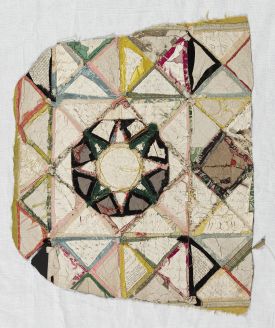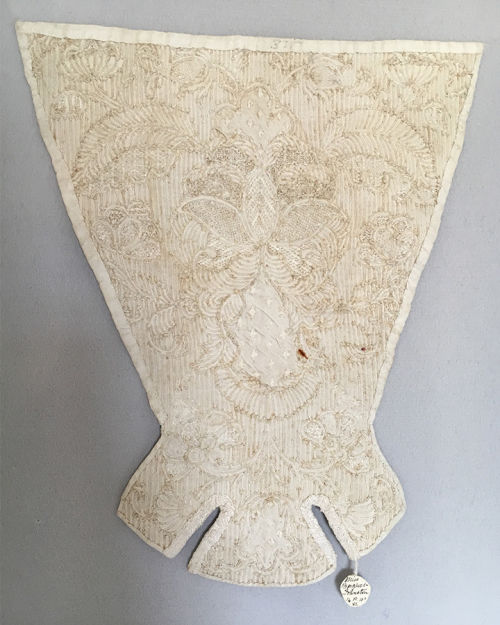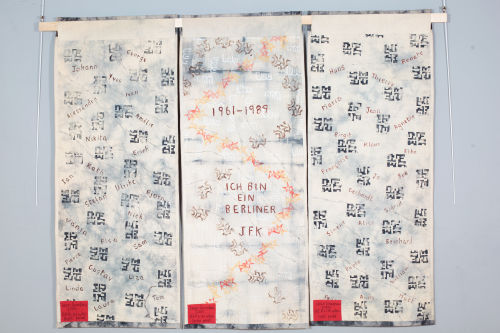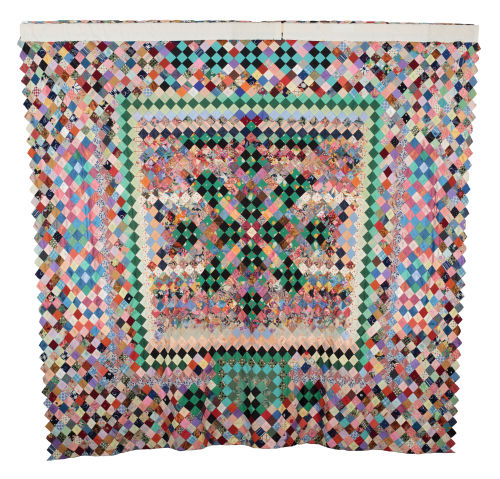What's on the back?
Published: Thursday, 25th June 2020 22:23 PM

When we see a beautiful quilt, either contemporary or historic, we are often keen to see what's on the back - to see any signs of construction, what fabric they used and sometimes if their stitches are as neat and regular as they are on the front! Most quilt exhibitions, especially of historic textiles, won't let you lift up the corners of a quilt to view the back. This is understandable as excess handling and the oils and dirt on our hands can contribute towards the deterioration of fragile textiles. But in a 'virtual' world we can see the back!
This mosaic patchwork chair seat cover from the mid-18th century looks beautiful in all its splendour from the front, with many silks containing metal threads - but it is equally as interesting from the back. The papers are still intact, and show evidence of recycling both printed and handwritten text, such as numbers from accounts, handwriting practise, repeated phrases from a copybook and personal letters. We can also see the tacking stitches which keep the paper in and only go through the seam allowance so they can't be seen from the front, and the neat over-sewing of the piecing.
The Wellington quilt (1820s-30s) features a colourful patchwork triangles design on the front with a beautiful block printed panel in the centre. Like many pieces made at the start of the 19th century, the back is made from plain fabric, but this does provide an opportunity to view the interesting and quilted design that is difficult to see from the front. This piece also features the printed stamp of the Irish Linen maker 'Edward Shannon, Colerain', with another stamp that says it is 'warranted'.
The corded quilting on this stomacher, dating from around the 1730s, was most likely done by a professional quilter. It is an unusual piece to survive from the 18th century, and is more unusual as it was made for this purpose rather than being recycled and cut down from another garment. The back of the stomacher shows the tufts from ends of the cords where they have been inserted into the tiny, delicate channels. An exquisite piece of workmanship.
This poignant piece was made by Jean Grimshaw in 2005, and represents an event that happened to the maker during her youth. Jean spent time in Germany with her pen friend whilst doing her A-Level German course. During her visit in 1961, the Wall was put up, with members of her friend’s family trapped on the East Berlin side of the wall. This event had a lasting impression on Jean, who continued to feel a deep connection with the city, visiting often. The quilt represents her feelings and experience of Berlin and its people, and her joy when the wall came down in 1989.
The front design features the wall with barbed wire quilting running across all three triptych pieces and uses fabric painting, appliqué, photograph transfers, quilting and embroidery. Many of the German phrases express hope, friendship and kinship. The quilt is also painted on the reverse, but this time with the names of those who died trying to cross the wall.
James Burt made this quilt for his friend Wilfrid McSloy when they were both being treated for tuberculosis in a sanatorium in Northumberland in the late 1930s. It took James a year to make by hand and he calculated he had used a total of 12,264 patches, sewn together at 16-18 stitches to the inch, taking 1,825 hours.
The front side is made of square patches on point with a border of larger rectangular patches set at an angle. This has also been embroidered to celebrate the Silver Jubilee of George V and Queen Mary. The reverse is also made of patchwork, all squares on point. The patches are a mixture of plain and printed dress cotton, silk and rayon fabrics.
 Wellington Quilt reverse showing linen stamp
Wellington Quilt reverse showing linen stamp
 Corded Quilted Stomacher
Corded Quilted Stomacher
 Berlin Wall Quilt Reverse
Berlin Wall Quilt Reverse
 McSloy Coverlet Reverse
McSloy Coverlet Reverse